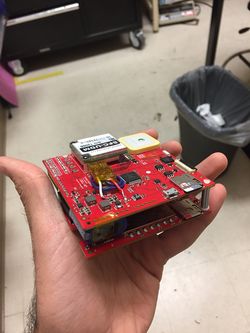Difference between revisions of "VB Gen 8.1 Avionics"
| Line 52: | Line 52: | ||
=== Firmware === | === Firmware === | ||
| + | |||
| + | === Connectors === | ||
| Line 73: | Line 75: | ||
=== Link Budgets === | === Link Budgets === | ||
| + | |||
| + | === Connectors === | ||
== Breakout Board == | == Breakout Board == | ||
| + | |||
| + | === Connectors === | ||
[[Category: High Altitude Balloons]][[Category: ValBal]] | [[Category: High Altitude Balloons]][[Category: ValBal]] | ||
Revision as of 02:56, 10 September 2017
| ValBal Generation 8.1 Avionics | |
|---|---|
| Part of the ValBal series | |

| |
| Chief Designer | Aria Tedjarati |
| Technology Line | Balloons ValBal Architecture |
| Version | Generation 8.1 |
| Name | ValBaby |
The ValBal Gen 8.1 Avionics is the eighth generation and twelfth iteration of of the ValBal core electrical architecture. It is the most up-to-date and highest performing ValBal avionics version as of September 2017, consisting of two 3-inch by 3-inch FR4 PCB's that are stacked on top of one another above 33 AA non-rechargeable lithium primary batteries, in addition to a small breakout PCB that is exposed to the air. The architecture makes significant changes and improvements on the ValBal Generation 8.0 architecture, including changes in physical size, stacking connectors, power regulation and efficiency, cost, wireless communication, and more.
The details of the ValBal generation 8.1 avionics are outlined below in exhaustive detail.
Introduction
ValBal is an actively altitude-controlled, low-cost, high-endurance, autonomous latex high altitude balloon system. It requires a complex set of avionics hardware to enable it to complete its mission. In general, at a bare minimum, any ValBal avionics system must have the following set of features to ensure a successful flight.
- Half-duplex or full-duplex wireless communication
- Dual bidirectional high power motor control
- High altitude GPS location acquisition capability
- Power regulation and subsystem protection
- Temperature regulation
- Barometric pressure & temperature sensing, filtering, and error detection
- Powerful microprocessor with autonomous flight code
- Current & voltage sensing of all system parameters
- Weigh no more than approximately 1 kilogram
- Have a form factor of less than 3 x 3 x 6 inches
The 8.1 generation of ValBal avionics goes above and beyond these minimum requirements.